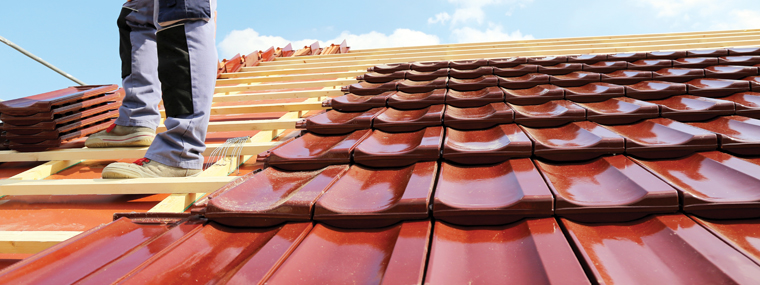
Get Ready for the Storm
Roof Maintenance Planning Can Help You Weather the Worst
By Gregg Wallick / Published July 2019

One of the factors that makes Florida so appealing is its weather. The warmth and sunshine are great inducements to anyone purchasing real estate in our lovely state. There is another aspect of weather we must consider when developing or guarding our real estate investments, which is the inevitable storms and hurricanes, which batter us fairly regularly.
While every element of storm preparation is important, the roof system is probably the most critical and most often overlooked. Consider that despite rain, hail, ultraviolet rays, foot traffic, various mechanical servicing, and building expansion and contraction, your roof system must continue to keep water from entering the building.
During a storm, the roof is a transfer point of wind energy and is part of your first line of defense against immediate and future damage. How your roof is built is as important as what it’s made of. Your roof system should incorporate the following considerations: access, deck, slope, weight, traffic, local weather condition, wind zone, codes, insurance, and budget constraints. Proper maintenance, and sometimes retrofitting of braces or hurricane straps, can help ensure that damage will be minimal when tough weather hits.
Every homeowners association should designate someone to be responsible for the roof of their building. The roof should be treated as a depreciating asset, and every step should be taken to manage this asset to ensure the benefit of its entire service life. Here are some things you can do to help you prepare for the worst:
Create a historical file
Every homeowners association should gather the following items:
- As-built roof specifications;
- As-built roof plan that shows the location of all penetrations and roof-top equipment;
- Material manufacturer specification and product data information on the different components of the roof;
- Roof warranties from the manufacturer of the material and/or the roofing contractor.
- Contact/contractor information and phone numbers, so you don’t have to search for them in the event of a crisis.
Conduct periodic inspections
Roof systems should be inspected twice a year by a qualified architect, engineer, roof consultant, or roofing contractor who has a good understanding of the basic components of the roof system. Spring and fall are good times to do this because they are prior to and just after the severe Florida rain and hurricane seasons. Additional inspections should be ordered after severe hail and windstorms or after any installation of new mechanical equipment. If you haven’t already assessed your property’s vulnerability to wind loading, now is the time to do it.
Roofs rarely fail all at once, and attention should be paid to each of the components. All good inspections should be performed with a checklist, which prompts consideration of areas of concern. The checklist should allow you to rate the condition of the different components of the roof system. Every roof is different and special conditions always come into consideration, but the following things should be addressed:
- Exterior and interior walls for cracks and moisture stains.
- Roof condition for debris, drainage surface deterioration, splits, blistering, punctures, etc. Make sure that there are no spots where water gathers on the roof.
- Surface degradation. Look for obvious signs of blistering and splitting of the membrane. This can indicate that the roof is separating from the structure.
- Flashing punctures and open seams. Flashings are a protective piece of sheet metal used where direction changes on a roof. This can indicate that the roof material is separating from itself.
- Caulking separation between counter-flashing and walls. This, too, indicates wear and can allow water and insects into the roof system.
- Coping cap attachments that appear worn or lack integrity. The coping cap is the piece of metal that sits on top of a parapet wall. A parapet is a wall above the roofline.
- Wall cracks and spalling. “Spalling” is stucco coming off the wall.
- Gravel stop splits and securement. Gravel stop is the material that holds gravel in place, and the securement is where the gravel stop overlaps and is held down.
- Excessive traffic wear.
- Cracks or splits in expansion joints. Look for a rubber bumper that allows expansion and contraction; that’s the expansion joint.
- Pitch-pan shrinkages. A pitch pan is the square metal box that surrounds any roof penetration. The sealant in the pan can shrink over time and needs to be maintained periodically.
- Wind hazards and weaknesses. Gabled roofs are particularly vulnerable and should be braced.
Utilize Preventive Maintenance
This is the action taken as a result of the inspection process. It is very important that you select a contractor who specializes in this area. Preventive maintenance is a special part of the roofing trade which is very different from conventional roofing contracting. Hiring a roof technician properly trained in all roof systems, who has served an apprenticeship of diagnosing the proper corrective procedures, is as important as taking your car to a mechanic who specializes in a specific make and model. Providing the contractor with all historical information, including the specific roof system, warranties, inspection reports, and a list of previous problems and corrective action(s) taken, will help ensure that the corrective process is performed properly.
Most roofs will be in decent condition, but almost every roof will require minor repairs. Some roofs will require significant repairs. If your roof is leaking, serious damage has already been done. Your roof insulation, if exposed to a leak, will lose most of its effectiveness, and your decking system could become questionable if exposed over a significant period of time. Damage to the roof can result in substantial water damage and ultimately lead to significant mold problems, so it is critical that you take every measure to avoid a problem before it starts.
Considering that your roof protects a significant portion of your real estate and personal assets, a few dollars in preventive maintenance is a worthy investment. If it’s been a while since your last roof inspection, you should anticipate a significant charge to bring your roof up to a manageable level. Once you’ve established a routine inspection/maintenance pattern, you can expect costs to range from $0.02 to $0.10 per square foot, per inspection. Considering the cost to reroof a building can run from $5.00 to $20.00 per square foot, extending the service life of your current roof through proper maintenance is worthwhile. When the maintenance or restoration work is finished, don’t forget to add the new information to your historical file. List what was repaired, how it was repaired, the cost, and who did the work.
The best emergency strategy that you can have is an established relationship with a qualified roofing professional. Don’t risk making the repairs yourself; it is dangerous for untrained individuals to climb on a roof, and attempts to make repairs without professional guidance can sometimes result in more costly damage. The National Roofing Contractors Association provides a wide range of information and services to help homeowners and building owners make informed decisions about replacing and maintaining their roof systems, including how to hire a professional roofer. Visit www.NRCA.net to learn more.
Gregg Wallick
President/CEO, Best Roofing, Ft. Lauderdale
A second-generation roofing contractor, President and CEO, Gregg Wallick’s knowledge and passion for the industry is the driving force behind Best Roofing’s outstanding reputation and success. In 2018, Best Roofing was named “Commercial Roofing Contractor of the Year” by Roofing Contractor magazine. He has served as the past director of the National Roofing Contractors Association and retains numerous licenses in the roofing field. For more information, call (888) 723-BEST (2378) or visit www.bestroofing.net.




